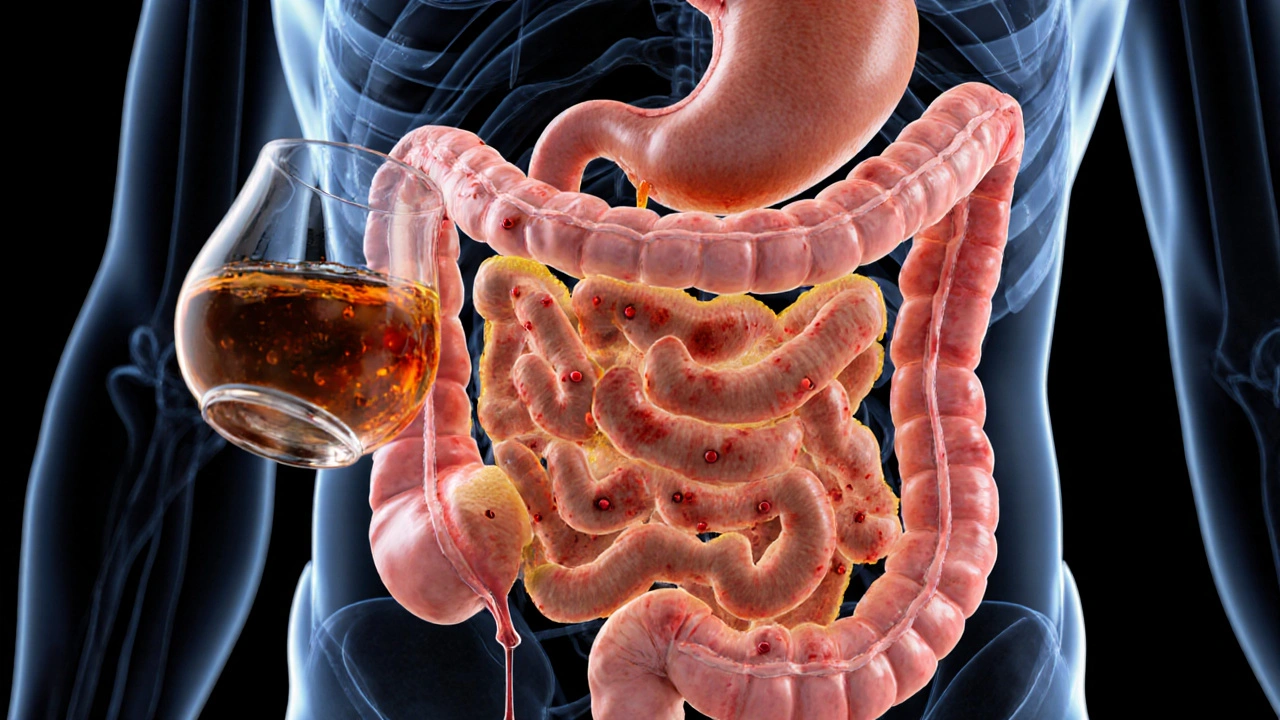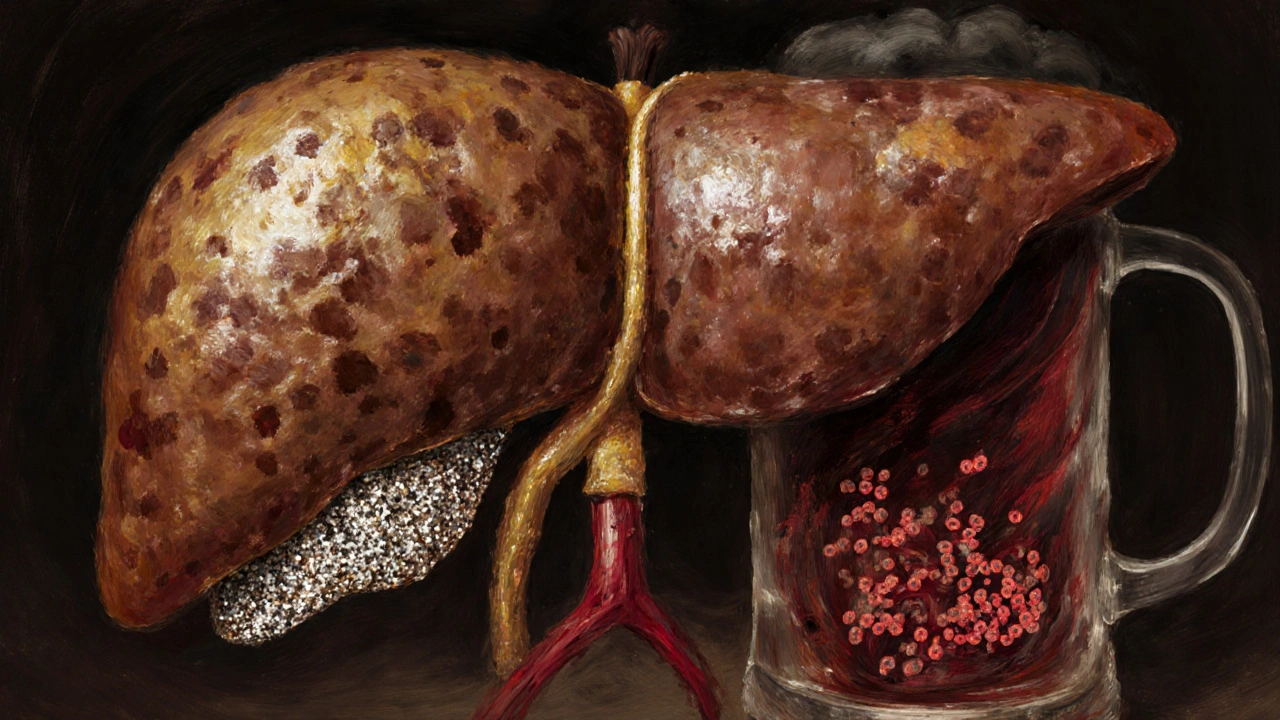How Alcohol Affects Anemia: Risks, Symptoms & Management

Alcohol & Anemia Risk Calculator
Your Risk Assessment
This calculator estimates your risk of developing alcohol-related anemia based on your drinking habits, diet, and health factors. Results are for informational purposes only and do not replace medical advice.
Key Takeaways
- Alcohol interferes with iron, vitamin B12 and folate absorption, worsening most anemia types.
- Chronic drinking can damage the liver and bone marrow, leading to reduced red blood cell production.
- Symptoms often overlap - fatigue, pale skin, shortness of breath - making diagnosis tricky.
- Cutting back on alcohol, improving nutrition, and treating underlying liver disease can reverse many anemia‑related issues.
- Regular blood tests are essential for anyone who drinks heavily and notices persistent tiredness.
When you hear the word Anemia is a condition marked by low hemoglobin or an insufficient number of red blood cells, you probably picture iron deficiency or a chronic illness. What many don’t realize is that alcohol can be a silent accelerator, nudging an already fragile blood system into serious trouble. This article breaks down exactly how drinking affects the blood, which anemia types are most vulnerable, and what practical steps you can take to protect yourself.
What Is Anemia? A Quick Primer
At its core, anemia means your body isn’t delivering enough oxygen to tissues. The primary culprits are:
- Iron deficiency - the most common form, caused by inadequate iron intake or chronic blood loss.
- Vitamin B12 deficiency - often linked to poor absorption in the gut.
- Folate deficiency - crucial during rapid cell division, such as pregnancy.
- Aplastic anemia - a bone‑marrow failure that reduces red blood cell production.
- Anemia of chronic disease - driven by inflammation or long‑term illnesses like kidney failure.
Each type shares the hallmark of low Hemoglobin levels, but the underlying mechanisms differ. Understanding those mechanisms is key to seeing where alcohol fits in.
How Alcohol Messes With Blood Production
Alcohol isn’t just a social lubricant; it’s a toxin that interferes with every stage of blood formation - from nutrient absorption to bone‑marrow health.
- Impaired nutrient absorption - Alcohol damages the lining of the stomach and small intestine, reducing the uptake of iron, vitamin B12, and folate. This directly limits the raw materials needed for red blood cell synthesis.
- Liver dysfunction - The liver stores iron and produces a protein called hepcidin that regulates iron release. Chronic drinking can cause fatty liver, hepatitis, or cirrhosis, all of which disrupt hepcidin balance and trap iron inside liver cells.
- Bone‑marrow toxicity - Heavy alcohol use suppresses bone‑marrow activity, slowing the production of all blood cells, including red blood cells, white blood cells, and platelets.
- Increased blood loss - Alcohol irritates the gastrointestinal tract, leading to gastritis or ulcers that bleed slowly but steadily, depleting iron stores over time.
- Inflammatory response - Alcohol triggers chronic inflammation, which can raise levels of cytokines that blunt red blood cell production, a hallmark of anemia of chronic disease.
In short, alcohol attacks the system from multiple angles, making it a high‑risk factor for almost every anemia type.

Alcohol’s Impact on Specific Anemia Types
| anemia type | alcohol’s primary impact | key mechanism | typical outcome |
|---|---|---|---|
| Iron‑deficiency anemia | Worsens iron loss & hampers absorption | Gastric irritation → chronic bleeding; intestinal damage → reduced iron uptake | Deeper iron depletion, longer recovery |
| VitaminB12 deficiency | Blocks B12 absorption | Alcohol‑induced atrophic gastritis reduces intrinsic factor production | Macrocytic anemia persists despite B12 supplements if drinking continues |
| Folate deficiency | Reduces folate levels | Impaired folate transport in damaged intestinal mucosa | Elevated homocysteine, increased risk of cardiovascular issues |
| Aplastic anemia | Exacerbates marrow suppression | Direct toxic effect of acetaldehyde on hematopoietic stem cells | More severe pancytopenia, higher infection risk |
| Anemia of chronic disease | Amplifies inflammatory cytokines | Alcohol‑driven liver inflammation raises IL‑6, which raises hepcidin | Iron trapped in storage, low serum iron despite adequate stores |
Notice the pattern: regardless of the anemia’s origin, alcohol tends to either steal nutrients away or poison the factories that make blood cells.
Spotting the Signs: When to Get Tested
Because many alcohol‑related symptoms mimic ordinary fatigue, it’s easy to ignore them. Keep an eye out for these red flags, especially if you drink more than three drinks a day:
- Persistent tiredness that doesn’t improve with rest.
- Pale or yellowish skin, especially on the inner eyelids.
- Shortness of breath during mild activity.
- Rapid heart rate or palpitations.
- Unexplained bruising or bleeding gums.
- Frequent headaches or dizziness.
If any of these appear, a simple blood panel - complete blood count (CBC), ferritin, serum B12, folate, and liver enzymes - can reveal whether alcohol is the hidden culprit.
Managing Anemia If You Drink
Quitting alcohol outright is the gold standard, but not everyone is ready for that step. Here’s a practical ladder you can climb:
- Reduce intake: Cut back to no more than one standard drink per day for women and two for men. The body begins to repair gut lining within weeks.
- Boost nutrients: Incorporate iron‑rich foods (lean red meat, lentils, spinach), B12 sources (fish, fortified cereals), and folate‑rich veggies (broccoli, beans). Consider a multivitamin that includes methylated B12 and folate.
- Address liver health: Limit sugary drinks, get regular exercise, and talk to a doctor about liver‑protective supplements like silymarin or N‑acetylcysteine.
- Medical treatment: If labs show severe deficiency, doctors may prescribe oral iron, B12 injections, or folic acid tablets. For bone‑marrow suppression, more intensive therapies (e.g., immunosuppressants) might be needed.
- Monitor regularly: Repeat CBC and nutrient panels every 2-3 months until values normalize, then every 6-12 months.
Remember, recovery isn’t instant. Red blood cells have a lifespan of about 120 days, so you may not feel a full energy boost for three to four months after correcting the deficiency.

Special Populations: Who’s at Extra Risk?
Some groups face a heavier toll:
- Pregnant women: Alcohol‑induced folate deficiency raises neural‑tube defect risk for the baby.
- Older adults: Age‑related stomach atrophy combined with drinking can dramatically reduce B12 absorption.
- People with chronic liver disease: Even moderate drinking can push a borderline liver into cirrhosis, worsening anemia of chronic disease.
- Individuals on certain meds: Antacids, proton‑pump inhibitors, and metformin already impair B12 uptake; alcohol adds another layer of risk.
If any of these apply, a proactive approach-regular labs, nutritional counseling, and, if possible, abstinence-is advisable.
Quick Action Checklist
- Schedule a CBC and iron/B12/folate panel.
- Track daily alcohol consumption for a week.
- Add at least one iron‑rich and one B12‑rich food to each meal.
- Set a reminder to repeat labs in 8 weeks.
- If labs stay low, book a follow‑up with a hematologist.
Bottom Line
Alcohol is a sneaky aggravator for almost every form of anemia. By cutting back, fortifying your diet, and staying on top of blood tests, you can halt the downward spiral and restore healthy oxygen transport. The sooner you act, the quicker your energy returns.
Frequently Asked Questions
Can moderate drinking still cause anemia?
Yes. Even one to two drinks per day can interfere with iron and B12 absorption, especially if you already have low nutrient stores. The risk increases with age or existing gut issues.
Is it safe to take iron supplements while drinking?
Iron supplements can still work, but alcohol irritates the stomach and may cause nausea or constipation. It’s best to limit alcohol until the iron levels normalize and to take iron with food.
Why does B12 deficiency cause a different kind of anemia?
B12 is needed for DNA synthesis in red‑blood‑cell precursors. Without it, the cells become oversized (macrocytic) and break down early, leading to a distinct pattern in blood tests compared with iron deficiency.
Can liver disease from alcohol cause anemia even if I’m not anemic now?
Absolutely. Liver disease raises hepcidin, a hormone that locks iron inside storage cells. Over time you can develop anemia of chronic disease without ever feeling faint.
What’s the fastest way to boost my iron levels if I’ve been drinking?
Focus on heme iron sources (red meat, poultry, fish) because they’re absorbed better than plant iron. Pair them with vitaminC‑rich foods (citrus, bell peppers) and avoid tea or coffee during meals, which inhibit absorption.

11 Comments
Honestly, booze ain't the hero for your blood. Every time you knock back another drink, you’re basically stealing iron from your own cells. Don´t think you can outrun the deficiency. It’s like trying to fill a leaky bucket - no matter how much you pour in, it just keeps draining.
When it comes to the relationship between alcohol and anemia, the conventional wisdom is that they simply don't belong in the same conversation, but that's a gross oversimplification that ignores the nuanced biochemistry at play.
First, ethanol metabolism generates acetaldehyde, a toxic metabolite that not only wreaks havoc on liver cells but also interferes with the gut's ability to absorb essential micronutrients like iron, folate, and vitamin B12.
Second, chronic drinking induces a state of oxidative stress, which accelerates the turnover of red blood cells, shortening their lifespan and thereby increasing the need for continual hematopoiesis.
Third, alcohol can directly suppress bone marrow activity, the very factory where erythrocytes are produced, leading to a hypo-proliferative anemia that is often mistaken for iron‑deficiency.
Moreover, the notorious 'drinker's anemia' is not a single entity but rather a spectrum ranging from macrocytic forms caused by folate depletion to microcytic patterns driven by impaired iron absorption.
If you examine the dietary habits of heavy drinkers, you will notice a tendency toward poor nutrition, with low intake of meat, leafy greens, and fortified cereals, all of which are primary sources of heme iron and folates.
The synergistic effect of alcohol-induced gastritis further compromises the stomach's acidic environment, which is essential for converting dietary iron into its absorbable ferrous form.
In addition, many prescription medications that are metabolized in the liver become less effective in the presence of chronic ethanol exposure, exacerbating deficiencies in the absorption pathways for B‑complex vitamins.
From a clinical standpoint, a patient presenting with fatigue, pallor, and a history of excessive drinking should be evaluated not only for liver function tests but also for a complete blood count with a peripheral smear, serum ferritin, and methylmalonic acid levels.
The diagnostic work‑up often reveals a mixed picture, with low ferritin indicating iron scarcity, elevated mean corpuscular volume suggesting folate or B12 deficiency, and sometimes even a reticulocytopenia pointing to marrow suppression.
Therapeutically, simply telling patients to stop drinking is insufficient; you must also address the nutritional gaps with targeted supplementation and dietary counseling.
Evidence suggests that a combination of oral ferrous sulfate, folic acid 1 mg daily, and vitamin B12 injections can reverse the hematologic abnormalities within weeks, provided the patient reduces alcohol intake to moderate levels.
Moderate levels, defined as up to three drinks per week for women and up to four for men, are still a subject of debate, but the consensus leans toward a lower threshold when anemia risk factors are present.
It's also worth noting that certain populations, such as pregnant women and individuals over fifty, have an inherently higher susceptibility to nutrient depletion, making alcohol's impact even more pronounced.
Finally, the psychological component cannot be ignored; many heavy drinkers rely on alcohol as a coping mechanism, and successful anemia management often requires interdisciplinary support, including counseling or support groups.
In summary, the interplay between alcohol and anemia is a multifaceted web of metabolic disruption, nutritional deficiency, and lifestyle choices, and untangling it demands a holistic approach rather than a one‑size‑fits‑all prescription.
Hey, thanks for sharing this. It’s really helpful to see the concrete steps people can take, especially the reminder about iron‑rich foods. Keep the info coming! 😊
STOP! YOU'RE BLIND TO THE REAL FACTOR-THE GOVERNMENT'S CHEMICAL ADDITIVES IN ALCOHOL THAT ARE *INTENTIONALLY* DRIVING POPULATIONS INTO ANEMIA!!! THEY DON’T WANT YOU TO KNOW THAT IT'S NOT JUST “METABOLISM” BUT A PURPOSEFUL DEPLETION!
From a clinical perspective, the key is to assess both dietary intake and drinking patterns simultaneously. A structured questionnaire can identify patients at risk before lab abnormalities appear. Early intervention with supplementation and counseling usually prevents progression to severe anemia.
Stay hydrated and add leafy greens to your diet for better blood health! 🌱
Interesting how different cultures view alcohol-some see it as a staple, others as a taboo. Understanding these attitudes can help tailor public health messages.
The pathophysiological nexus between ethanol ingestion and hematopoietic dysregulation underscores a profound ethical lapse in public health policy; bioethical frameworks demand proactive mitigation strategies to curtail iatrogenic anemia prevalence.
While many point to alcohol as the sole villain, it’s worth noting that lifestyle factors, such as sedentary habits and low‑protein diets, often play an equally pivotal role in anemia development. Ignoring these co‑variables leads to an oversimplified narrative.
Yeah, sure, blame the booze, but half the time folks are just skipping meals. It's not all about the drinks.
Let’s get real-if you’re hitting the bottle hard, your body’s going to scream for iron, folate, and B‑12. The good news is you can turn this around with a solid plan: cut back, load up on red meat, leafy greens, and fortified cereals, and consider a supplement regimen after talking to a doc. It won’t be painless, but the payoff is worth the hustle. Stay motivated, share your progress with friends, and remember that every small win adds up to big health gains. You’ve got this, and we’re all cheering you on!